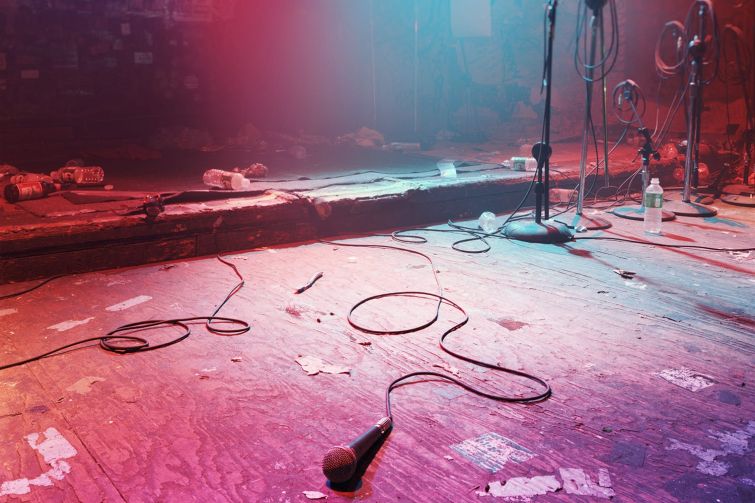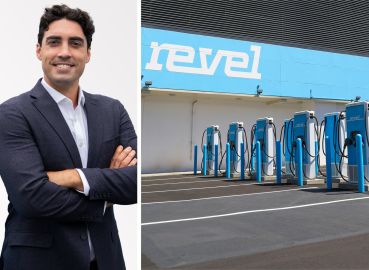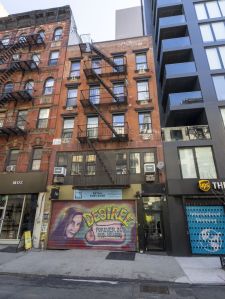New York Nightlife Has Gone Dark Thanks to COVID-19. What Happens Next?
So far, 82 percent of city venues have not been able to negotiate any relief from their landlords
By Aaron Short September 16, 2020 9:41 am
reprints
When some in the New York nightlife industry felt that high costs and burdensome regulations threatened their existence, they threw a party.
A conga line of performance venue owners, DJs, club kids and punk rock icon Marky Ramone sashayed through Bushwick’s House of Yes nightclub on a Tuesday night in September 2017 to celebrate the creation of a new agency dedicated to their concerns.
It was a hopeful note for late-night revelers after one-fifth of city nightlife venues shuttered due to rising real estate costs over the last two decades.
“It’s pretty shocking — one in five small businesses have been lost in the last couple of decades in New York City,” said Mayor Bill de Blasio, who attended the ceremony. “And one of the big reasons was it was hard to navigate the rules and restrictions that in so many cases went too far.”
Venue operators had been organizing for several months to strengthen their voice within city government to handle complicated licensing and permitting rules, neighborhood noise complaints and unwanted police attention.
They scored another victory seven weeks later when the city revoked a century-old law that barred dancing in places without a city-issued cabaret license. Club operators wouldn’t have to worry about facing excessive fines if their patrons suddenly started swaying in the middle of a set.
The law’s repeal and the de Blasio administration’s appointment of a “night mayor” modeled after a popular Amsterdam initiative earned international headlines and reinforced the city’s position as a global destination for music and entertainment.
Three years later, as the deadliest pandemic in a century stretches into its sixth month, New York nightlife is gasping for survival.
On a Tuesday afternoon in August, a small crowd of musicians and venue operators donned facemasks and gathered in respectful distance apart from each other on the sidewalk outside Williamsburg’s Baby’s All Right concert hall to plead for congressional aid.
Senate Minority Leader Chuck Schumer, who once preserved a nearby summer concert series that was in danger of dissolving a decade ago, vowed to help venue owners gain funding.
“People from around the world come here because they want to get a start in a live venue,” said Schumer, a few hours before addressing the nation at the Democratic convention. “These places have to survive. Saying ‘well, we can do without these’ is like saying you can do without your liver or your right arm.”
The onslaught of COVID-19 throttled New York’s entertainment and leisure industries.
When the city declared a state of emergency on March 12 and quashed large gatherings to slow the spread of coronavirus, many businesses saw revenues dry up. Many had no choice but to shutter their doors with tourism sharply down and events across the city canceled indefinitely.
By April, the state’s hospitality and leisure industry had laid off two-thirds of its workforce, keeping only 343,000 people on the payroll after employing 965,000 people a year ago, U.S. Bureau of Labor statistics showed.
Restaurants and hotel employment has slowly rebounded over the summer as coronavirus cases across New York dwindled and the city allowed outdoor dining. By July, roughly 539,000 people were working in the hospitality industry but the figure was still 44 percent below the previous July’s labor force of 960,000, records showed. Nearly 20 percent of city workers remain unemployed.
Music venues have suffered more than restaurants. New York contains roughly 2,400 such spots that employ 19,900 workers and contribute $1.2 billion in economic output, according to a 2019 city report, but officials have not tracked how many venues have closed since March.
The state put arts and entertainment institutions in its fourth and final reopening phase, after offices, shops and restaurants could proceed. Moreover, state guidelines limited capacity for a concert outdoors to 33 percent of a location’s usual hold and only 25 percent for indoor shows to ensure guests stay 6 feet away from each other at all times.
Those restrictions have hindered many clubs from opening even when coronavirus case numbers remain low, said Ariel Palitz, senior executive director of the city’s Office of Nightlife.
“Live music and performance venues have not yet been given the opportunity to open at any stage,” said Palitz, who was appointed the city’s first night mayor two years ago. “Some of them are just using their loans and other means to sit and wait it out for what’s next over the next six months. So many venues are sitting idle in a sort of purgatory where they’re not open or closed but undecided.”
The consequences of sitting back and waiting out COVID-19 could be dire. Many venues had applied for and received federal small business loans, but without further assistance 90 percent of independent venues nationally could close before the end of the year, according to the National Independent Venue Association, a group formed in March in response to COVID-related closures.
“Venues want to open up to give jobs to their employees and artists and help restart the economy and begin to heal our state culturally,” NIVA vice president Justin Kantor told CO. “Opening at 25, 50 or even 80 percent capacity will not be profitable for these businesses, but we all want to get back to work and start the process.”
Most venues have had to lay off or furlough the majority of their staff while keeping only two or three key employees on the payroll. That includes an array of sound and lighting professionals, security, floor staff, bartenders, cleaning crew and kitchen workers, not to mention the DJs and musicians who depend on bookings and the ancillary businesses such as sound equipment rentals and rehearsal studios that support live events.
“Our members who are artists and DJ performers themselves are unemployed and that has a lot to do with venues being closed,” Rafael Espinal, Freelancers Union executive director and a former Brooklyn councilman, told CO. “Workers can’t get back to work or perform, and what I’ve been hearing is that venues are writing this year off as a big loss or advocating for permitting on our streets.”
With little likelihood of fully reopening until 2021 and no other source of revenue, independent venues need $40 million, or an average of $350,000 per site, to survive through the end of the year, NIVA estimated.
In the meantime, many venues, artists and DJs have found creative ways to raise funds while entertaining patrons during the pandemic. Baby’s All Right launched a streaming platform in March featuring musicians performing from their homes with proceeds benefiting staff ineligible for governmental assistance.
Bushwick’s Elsewhere reopened its outdoor rooftop in June with strict protocols, including mandatory temperature checks and face masks and a limit of 50 guests allowed. And Bushwick’s House of Yes had been offering digital dance parties in addition to yoga sessions and burlesque shows before adding an outdoor market and happy hours in its outdoor lounge.
“It felt good to throw ourselves into a new project during a time of immense uncertainty when we’re not sure what the future of nightlife holds,” Jacqui Rabkin, House of Yes marketing and cultural director, told CO. “It’s so important to keep creating during these times and find new ways to foster connection between people in our community. We knew our audience would be hungry to connect digitally and dance together in whatever way possible.”
But reopening during a pandemic has been tricky. The State Liquor Authority pulled the House of Yes’s liquor license in late August after investigators found the club was “overcrowded” and served alcohol without food on Aug. 21 in violation of state COVID regulations. House of Yes officials said the venue would temporarily close and work with the SLA to restore its license.
What’s more, venue operators have had difficulty raising enough cash to cover their most substantial fixed costs. That comes to an average of about $200,000 per tenant, or $5.2 million total, NIVA calculated.
Ridgewood’s Nowadays, whose backyard is open, reports covering 45 percent of its monthly expenses through the fundraising platform Patreon. And House of Yes raised $41,000 to pay for furloughed staff, which shrunk from 75 before the pandemic to seven. But its fundraising and party revenue still isn’t enough to cover its monthly rent.
So far, 82 percent of city venues have not been able to negotiate any relief from their landlords, according to NIVA. Those that received a break have merely negotiated rent deferrals instead of reductions. Now that the state’s moratorium on commercial evictions expired on Aug. 20 — residential tenants get a reprieve through at least Oct. 1 — landlords can demand back rent and take tenants who missed payments to court.
Some venues remain in limbo. QED Astoria, a comedy club and community arts space in northwest Queens, held events in its outdoor backyard but was forced to suspend them when the State Liquor Authority banned live entertainment. The club’s owner Kambri Crews received a PPP loan to pay four staffers and dozens of contractors but has had difficulty negotiating with her landlord and has only been paying half her rent per month.
“I’ve tried to talk with my landlord but he keeps brushing it off,” Crews told CO. “It’s clear from my attempts to broach the conversation that he doesn’t want to commit to anything even informally, so I’ve been paying half rent and waiting to see what will happen.”
Nightlife industry advocates say it is time for public officials to go beyond paycheck protection program loans and help venues weather lengthy closures.
“We need grants straight up,” Kantor, NIVA’s vice president, said. “Low and no-interest loans still show up on our balance sheets and will need to be paid back. Our industry was doing it right —we were on average showing amazing growth and now we have put the brakes on for the greater good.”
Lawmakers have been pushing different initiatives to provide businesses financial assistance and lower costs. Last month, Minnesota Sen. Amy Klobuchar and Texas Sen. John Cornyn introduced the Save Our Stages Act, which would provide $10 billion in relief for independent music venues over a six-month period. Schumer said he hopes to include the bill in the next coronavirus relief effort Congress passes, but talks have stalled.
State legislators have focused on rent relief efforts, providing $100 million in rent vouchers for residential tenants in May, but there has been little movement for Queens Sen. Mike Gianaris’s bill that would suspend rental payments for 90 days for residential and commercial tenants. And Brooklyn Assemblyman Robert Carroll is pushing a proposal allowing businesses that shuttered during the pandemic to collect insurance on vaguely worded claims that excluded viral outbreaks.
“Thousands and thousands of businesses in March and April all put in claims and thought they were covered, and they were gobsmacked when they were rejected,” Carroll told CO. “We have to get these businesses money, and we have to get the economy revived. This will not only save countless small businesses and stop people from leaving New York, but help businesses pay rent, taxes and their employees again.”
City leaders meanwhile have sought to ease regulations involving outdoor dining and drinking to allow venues to reopen more easily. Last month the Office of Nightlife announced a new mediation program to resolve quality of life disputes between venues and neighbors and assist venues having difficulty negotiating with their landlords. And the city Parks Department is allowing outdoor gatherings up to 50 people in its parks although any event with a crowd of more than 20 people needs a permit that includes a checklist for dealing with COVID-19.
But the city has been slow to open public spaces for music and events held in a safe, socially distant way. Some comedy clubs have held unsanctioned sets in parks, and advocates want streets open for concerts before the weather gets too cold.
“Nightlife should be incorporated into our open streets program,” Espinal, the Freelancers Union executive director and former councilman, said. “I’ve heard from certain business owners where a street was not closed and a street around the corner was closed, but there’s little economic opportunity there. People feel left out of the program.”
The long-term consequences of venues disappearing across the city will be devastating. The loss of these venues could lead to a ripple effect through the communities in which they are located, affecting the restaurants, small businesses and housing in those neighborhoods.
“This is an infrastructure policy and it has to be seen as an infrastructure policy that requires funding,” LCD Soundsystem frontman James Murphy said last month. “Even if all we care about is the bottom line we see this city exports creative work. This is what we do as a city, and that work is sponsored and fostered by the independent venue and promoter scene just like it is in every other part of this country.”
Keeping nightlife afloat during the pandemic will be critical to stabilizing New York’s economy and preventing the creative class from leaving the region, proponents of additional aid say.
“It is imperative that we do everything we can to preserve and protect their ability to weather this storm,” Palitz, New York’s night mayor, said. “It is devastating beyond measure to lose one, much less the prospect of many many more. We hope we can survive this with our health, culture and economy intact.”


